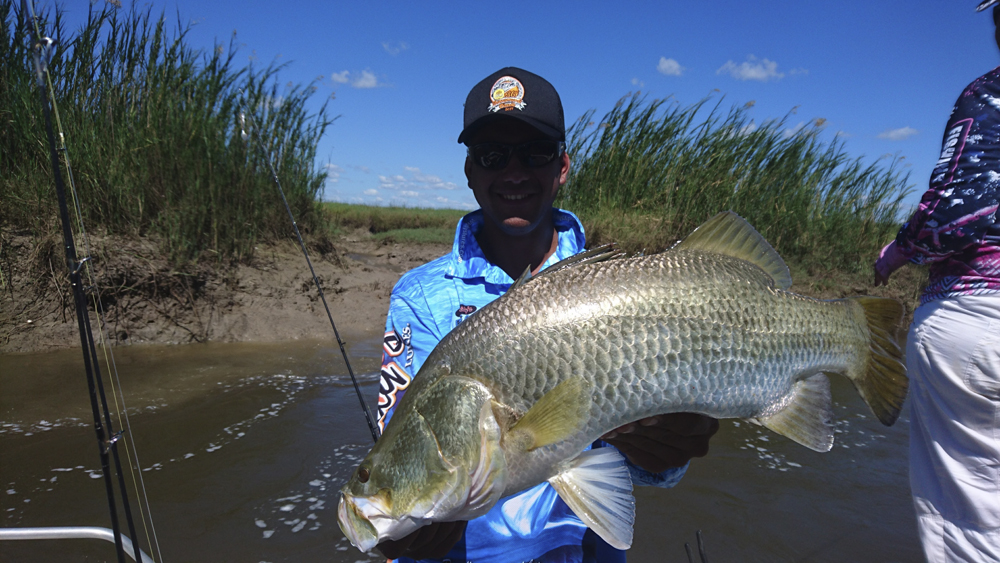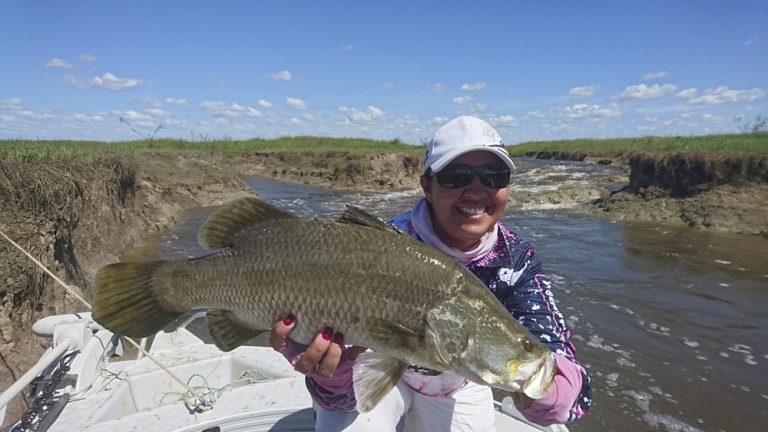Fishing the Channels. By Jason Nat Rogers
I love the run-off, it’s that magic time of the year when you can catch lots of barramundi in the Top End of the Northern Territory. And I love catching barra, especially in an environment and setting which is so remarkably breathtaking and wild.
The untamed beauty of the floodplains astounds me every time I visit these areas. They are constantly changing from season to season, and this adds to my excitement each time I go out while chasing the highly sought after sports fish: the barramundi. Whether I’m heading back to a spot I haven’t been to for a while or somewhere I have never been to before, discovering the changes and the visual cleansing of the landscape and the pure abundance of life of all kinds, that a receding flood reveals, never gets old. This is the time of year you’ll encounter lots of small barra with trophy-sized models mixed amongst them.

As the wet season ends, and the storms subside, so do the inland seas and flooded river catchments. Many types of fish and creatures that have lived there and sought refuge from the floods are now being funnelled into veins that feed the headwaters of many big rivers. Instead of being spread out hiding in the grasses and the vast expanses of millions of litres of water, they become easy prey to the larger predatory fish that make the most of this time and feed on them as they are washed into the channels. Each of these channels now becomes a smorgasbord for fish like barra to get an easy and plentiful feed. Tiny pockets of land start to protrude, creating waterfalls and many back eddies where predatory fish will hold up and wait for their meals to literally fall into their mouths. The smaller prey becomes an easy target after being disorientated and sucked into the vortexes and currents of the floodplain channelling into the rivers. This can also create a great opportunity for fishermen to make the most of the predators in these channels as they are so condensed in tight bodies of water, it makes catching barra a lot easier (like shooting fish in a barrel). This time of year also offers a land-based option whilst out in the boat.

Once you’ve made your way up a channel, it is sometimes easier to sneak up on fish by foot. I love doing this, as it presents a different style of fishing to the day. In some spots, you just can’t get a boat in, so walking along the bank of a narrow channel with fast flowing water is your only option. Quite often you will have a good vantage point on the bank and be able to sight cast to fish. If you are going to do this, you must be vigilant of your safety as these areas are where crocodiles live and nest. Always assume there is one nearby, never get complacent. If you see a threatening crocodile, remember this is their habitat and move on, find another spot away from their territory.
Early in the run-off, the water in these areas is pretty much pure fresh water. Tidal variances can have a great influence on the success of catches as the incoming tide from the lower reaches will slow the flow of water, therefore, backing up the floodwaters. This provides easier access and movement for the larger fish to swim up with the tide and begin to feed more easily. Although these areas can nearly always have resident fish, the incoming tide will most definitely bring more fish. I like to fish the incoming spring tides due to the big tidal push that backs right up to the top of the rivers, and in some cases, on the larger tides, it can even flow into the freshwater areas right on the top of the tide. Once it turns to run out, this can cause another release of bait and fish from the Billabong resulting in a brief but exciting feeding period.

In the coming weeks as the flood water drops further off of the plain reducing to just a trickle the rivers and channels really start to be affected by the tide. The fish higher up in the system seem to sense what is happening and escape to these channels where they concentrate, as opposed to being spread out through the grassy areas of the plains. The fish that are in the billabongs start to feel the surge of the top of the tide when the water backs up into the billabong areas that become landlocked in the dry season. This might be the last time for some fish to escape to the sea for the year, and many fish make a mass exodus from their freshwater prisons before the flood waters drop to a level where they can’t get out. This special area between the billabongs and the rivers becomes an area where saltwater fish head up to feed chasing some of the seasonal bounty of floodplain food before they must revert back to the saltwater environment. As the water slows and drops off the floodplains and out of the billabongs, the food supply coming from these areas start to dwindle. Fishing will now become more dependent on the tides, and the timing of trips will be crucial to success.
Fishing to me is a series of observations, and you catch more fish if you observe what is happening through the various stages of each tide. Birds congregating along the banks is a tell-tale sign of bait congregating. It all helps you find where the fish are.

It is unbelievable the size and quantity of fish you can encounter if you perfectly time your visit to these areas. This is what all the people who venture to the Territory strive to achieve each year in their quest for cricket score catches in fish and those big girls. So often, people tell me they were here last year or the year before and caught heaps, but unfortunately the conditions this year are different, whether the water levels are higher or lower than the year before when they were lucky enough to be in the right place at the right time. You have to keep watching the yearly flood levels and fish the appropriate areas at that right stage. It is rarely the same each year due to varying rainfalls in different areas that affect the amount of bait flowing from the wetlands. These conditions are constantly changing, and so you have to adjust where you fish in-line with what the environment dictates to you. Most fishing guides call their customers ‘punters’, I think this stems from them making the booking usually in advance hoping they get the timing right to get that magical trip of a lifetime, literally taking a punt.

I’ve been lucky enough to have been ‘Johnny on the spot’ on many occasions, and through observing the changing conditions, I have been privileged enough to see fishing in the Top End at its best and sometimes its worst, but we are all at the mercy of the weather and the environment. These are the major factors which dictate the barra fishing in nearly all areas, well at least the ones I’ve fished over the last thirty years. But for me, I just love being in these channel areas, fishing from the banks, standing barefoot in the rice grass casting into small crystal clear gushing waterways, then having a fish explode from the water whether it be a magical 1m model or a 30cm rat, while a wild boar walks by and stops to see what all the fuss is about. While all this unfolds, you are still keeping your wits about you as you can always bet those beady eyes of a croc will be watching from somewhere. It’s just a pristine environment, one in which I feel I have been lucky enough to have experienced, and I hope I can continue to experience for years to come. At this time of the year, I like to use soft plastics, as well as vibes as I think they are a lot closer to resembling what the fish are eating. I use a simple lift, drop, wind method of retrieval. On many occasions, the barra smack the plastic on the drop so it can take a little getting used to using these lures if you are not all that familiar to fishing with them, but they are a wise inclusion in your tackle box during the run-off. I’d add that it’s also handy to have a variety of sizes and colours.
I hope this has given you a little insight into this wonderful part of our Top End and I hope you can get lucky enough to time your trip to hit the jackpot.





